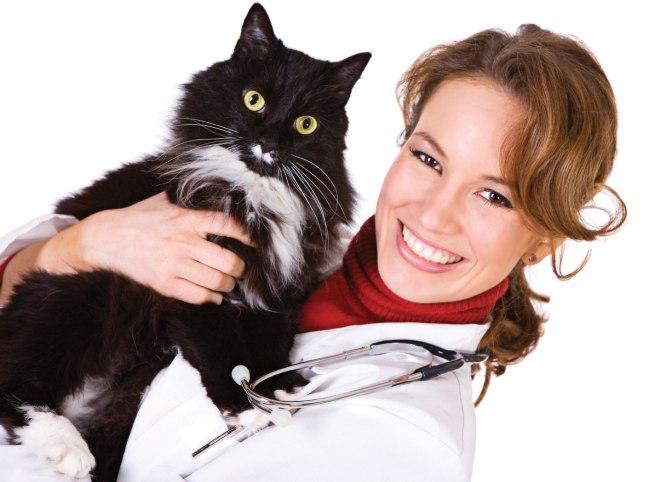Keeping a cat in perfect health means providing correct food, grooming, housing, and inoculations at the required intervals as well as a constant show of affection.
Correct feeding
This involves giving enough food of the right kinds, mixed in the correct proportions, enriched with dietary supplements as necessary and offered at intervals that depend on the age and condition of the cat. Titbits between meals are not a good idea, however amusing to the owners and their friends) A cat should know by repetition when and where to expect meals, and will then usually present itself at the right place at the right time.
Grooming
Regular daily grooming is essential for the health of all cats, twice daily being ideal. A well-kept cat should have a glossy or shining coat with visibly separate hairs and no tangles. There should be weekly attention to the eyes, ears, teeth and claws.
Housing
All cats should have a place of their own. A pet cat needs a bed in a warm, dark, draught-proof corner of a room, while a breeding queen needs her own quarters. If your pet is a Siamese or Burmese it may need warm bedding or even a heated bed, for these breeds feel the cold more than others. In fact, if allowed to, they will frequently prefer to sleep with their owners or any other cats or dogs in the household. From their viewpoint this is quite practical: most cats are adept at moving out from under, if rolled upon. All cats should have a choice of a warm or cold area of bed to lie on, so that they can move over to the cold part if they get too hot, or vice versa. In hot climates air conditioning may be required.
Inoculations
The most prevalent serious diseases can be prevented by the right injection at the right time. Kittens receive some immunity from their mother for the first eight weeks of their lives. After this, they need their first jabs for feline enteritis, a widespread and potentially fatal disease, and against respiratory diseases. In each case your veterinarian will provide a certificate which you may have to produce when your cat goes to stud or to a boarding cattery.
Loving
No cat is completely happy without some individual attention from its owner. For its psychological well-being it needs to be stroked and petted and talked to at some time during each day. Most cats will amply respond to any attention they receive and will reward their owners with a lifetime of devotion. Someone once said, ‘There are no dull cats, only dull owners.’ An interested owner will produce an interesting cat.
Nursing the sick cat
A healthy cat will be alert and friendly, with clear shining eyes and clean shining fur. It will purr a great deal. Any deviation from this norm means that something has gone wrong. The trouble may be an injury. Some cats are very accident prone, but their reputation for having nine lives reflects an ability to recuperate from the most amazing mishaps. However, nursing plays a very important part in recovery. This can be even more important in illness due to disease. A sick cat easily gives up the will to live, unless a human friend is prepared to take the trouble to nurse it back to health.
Water is more important than food to a sick cat and it must not be allowed to become dehydrated. Even when unable to eat or lap, the sick cat can take water administered by eye dropper or by a curved foster-feeding bottle. You can also drop small pieces of raw meat to the back of the throat, but avoid struggling with the cat as this
Taking a cats temperature may require two people. One holds the cat’s head and front feet, the other introduces the thermometer into the rectum, having first lubricated it with petroleum jelly. The second person may also have to hold the rear feet.
Eye drops are put into the eye while the head is lifted and kept still. Again, it may be necessary to hold the front paws or wrap the whole cat in a bath towel first to stop it interfering with what you are doing.
Here are a few more chores you may have to perform for a sick cat. If it is bedridden?perhaps immobilized by a fracture ? you may have to turn it from time to time to prevent bed sores. If there is diarrhoea, you must clean it up. If the cat is off its feet for some time you may have to trim its claws (cut the tips only, not into the quick).
Sometimes the veterinarian may recommend a steam bath. The best way to give this is to put the cat into a plastic-coated wire basket, cover the top and sides of the basket with a towel and stand it in the vapour rising from a hot bath of water. In this way, the cat breathes in some of the vapour, which helps to relieve nasal con?gestion. Any mucus round the nose, eyes or mouth must be sponged away with damp cotton wool. Do not add any inhalant to the steam bath without veterinary instruction.
Sick cats often try to run away and hide, but you must not allow them to do so. Place a sick cat in a dark quiet place, with warmth if required, and talk to it reassuringly from time to time without undue fussing. If the disease is trans?missible you must keep the cat isolated, and enter other homes containing cats only after changing your shoes and clothes and washing your hands.
After the illness has subsided, restrict the diet until the patient’s stomach can again cope with normal food. Most sick cats do not groom themselves but will appreciate their owner taking the time to do so.
Common accidents
Most road accidents involving cats happen at night or in the early morning. To avoid this risk keep your cat in at night if you can. Cats that have been neutered or spayed (and that should be all cats not being used for breeding) will be quite happy about this. If used for breeding, they will be confined to quarters anyway.
Abscesses
These tend to occur in free-ranging cats and are the result of fighting with other cats or, less commonly, from bites from rodents such as rats, mice or squirrels. Cats confined for breeding purposes seldom have abscesses.
Signs and symptoms:
Swelling under the fur, hot or hard and painful to touch. The swelling is caused by bacterial infection.
Basic Health Care
Fractures:
Fractures are often sustained in road accidents; or by falls from high windows, buildings or trees; or by heavy objects falling on a cat. Thus fractures are most frequent among free-ranging cats and are commonest in legs, jaw, pelvis and spine. People who keep cats in high apartments should have the windows wired over because it is not unknown for a cat to jump out of the window after a bird.
Signs and symptoms:
Bones sticking through fur Bones at wrong angles
-
- Inability to move or eat
-
- Limping gait
-
- Irritability at being touched Complete or partial paralysis
What to do:
Call the veterinarian or take the cat to his surgery as soon as possible, disturbing the cat’s body as little as possible.
If the wound oozes much blood, stem the flow with a pad or bandage. If the mouth is bleeding, hold the head lower than the body and facing downwards, so that blood does not run down the throat. If the body is bleeding, the head should be higher than the body. The veterinarian will repair the fracture and may plaster or bandage as necessary.
Burns
: These are generally caused in the home by spillage of hot liquids, electrical appliances (as with kittens chewing through electric cord) or chemicals.
Signs and symptoms:
Hair pulls out or is lost spontaneously.
-
- Signs of burns are visible at contact points.
-
- If burning is extensive, shock, collapse and unconsciousness will be apparent.
What to do:
Call the veterinarian for advice, having ensured safety from further burns by disconnecting electric cord, moving the cat or removing the source of further burns in the case of chemicals. In severe cases, symptomatic treatment such as artificial respiration and warmth should be applied, but since the treatments for the various types of burns vary with the cause, it is difficult to give any blanket advice. In cases of chemicals on the skin, these are best removed by bathing the cat in a suitable mild shampoo, and it is important that cats should not be allowed to lick the burns for fear of swallowing the chemicals, thus causing internal damage. In this respect, an Elizabethan collar may be helpful. As with human burns, treatment may require intensive hospitalized care, which can only be provided by a veterinary establishment.
Poisoning
Cats may eat houseplants (some of which may be poisonous) if they have no access to grass. It is always recommended, for indoor cats, to grow special grass in trays to satisfy their liking for vegetable matter. Drugs of any sort should, of course, never be left lying around the house; cats are known to be particularly sensitive to such commonplace drugs as aspirin. If it is suspected that a cat has ingested drugs of any sort, the name of the preparation or the purpose for which it was prescribed should be advised to the veterinarian, who should be contacted immediately. Guidance can then be given. Unfortunately, cats in the process of exercise , tend to come into contact with paraffin (kerosene), turpentine and sump oil in garages and outhouses, and seem particularly attracted to car antifreeze, all of which are potentially dangerous. Such materials should never be left around, and should be hosed away with a detergent if spilled accidentally. Also, a wide range of chemicals such as coal-tar derivatives (wood preservatives, disinfectants) can be hazardous, as can household disinfectants, fly sprays and mouse and rat poisons. Again, where urgent treatment is necessary, a sample of the material or an, exact description of the contents of suspect packets is of great assistance to the treating veterinarian.
Signs and symptoms:
-
- Salivation
-
- Convulsions
-
- Tremors or fits
-
- Vomiting
-
- Pain
-
- Weakness or dullness Excitability
-
- Death
W
hat to do:
Cats may be made to vomit, providing this is done within minutes of swallowing the suspect substance. After, say, 30 minutes, there is little point, for the toxin will have been absorbed. The best emetic is a crystal of washing soda pushed straight down the cats throat, which will be effective within seconds. Alternatively, a strong salt-and-water or mustard-and-water solution may be given by the method described for administering liquid medicines.
Parasites
Various small organisms live on or in cats. Where large numbers occur in a cat they may impair the animal’s health. Most spread from one cat to another via faeces or fur; a few may pass into kittens through the mother’s milk.
Internal parasites
Roundworms Ascarid roundworms found in cats are thread-like, off-white creatures 5-13cm (2-5in) long. They live in the gut of the cat and may be coughed up or passed in faeces.
-
- Signs and symptoms: Severe coughing
-
- Distended stomach (particularly in kittens)
-
- Diarrhoea
-
- Dull coat and eyes Ravenous appetite
-
- Haws up (third eyelid visible)
What to do:
The veterinarian will almost certainly prescribe a piperazine compound, the dose depending on the size, age and weight of the cat. It is advisable to dose kittens and cats every year, giving a second dose two weeks after the first, but a sick cat should never be wormed, as this could be fatal. Also you should worm queens before they go to stud and not after, when pregnant. Studs should be wormed regularly. Cattery hygiene is very important in the control of worms.
Hookworms
These have particular significance because they suck the cats blood fromtheir position anchored inside the intestines. Anaemia can therefore be a symptom of this parasite, which is much more common in the United States than elsewhere.
Tapeworms
T hese are segmented flatworms. A tapeworm lives in the gut with its head attached to the cat’s intestine. From the tail end of the tapeworm segments full of eggs drop off and are passed out from the cat with its faeces.
Signs and symptoms:
Small rice-like segments, sometimes still moving, appear on the fur around the anus. They show up better on dark-coloured cats than on light-coloured ones.
What to do:
Fleas are the intermediate hosts in the tapeworm cycle, so that flea eradication must go hand-in-hand with oral dosing against tapeworms. Other tapeworms are transmitted by mice, voles and rabbits which may have been eaten by free-ranging cats. Therefore hunters should be wormed regularly. There are various drugs which will rid the cat of tapeworms easily and with the minimum of side effects, but these tend to have to be repeated because of the animal becoming re-infested. It is recommended to seek advice from your veterinarian on the best dose.
Coccidia
These are microscopic unicellular organisms that inhabit the intestine and to which a variety of symptoms are attributed. They are rarely a major problem except in certain localized catteries in various parts of the world.
Signs and symptoms:
-
- Persistent intermittent diarrhoea Loss of weight and condition Blood in faeces
-
- What to do:
-
- Scrupulous attention to hygiene is essential and particularly safe disposal, such as incineration, of soiled litter. Drugs are available from veterinarians to eradicate the coccidia.
A unicellular organism called Toxoplasma, considered to be a natural parasite of the cat, is thought to be particularly hazardous to pregnant women.
External parasites
Fleas
These are hard-backed, brown, wingless insects, flattened from side to side. Cat fleas live in a cats fur and feed off their host’s blood. They occur only in temperate and tropical climates and are virtually unknown in northern regions such as much of Scandinavia. Cat fleas will bite a dog or a human but will seldom stay on either, much preferring a cat host. They are mostly found round the back and bib. Heavy flea infestation can lead to anaemia, eczema and other troubles.
Signs and symptoms:
-
- Dermatitis (eczema)
-
- Scratching
-
- Restlessness
-
- Skin feels gritty
-
- Visible manifestation: fleas run and jump
What to do:
There is a wide range of insecticides effective against fleas. They are ideally used in powder or aerosol spray form, and may be supplemented by use of an impregnated flea collar, though feelings about the safety of these are very mixed. Cats can be bathed in cases of most severe infestation, although cats are especially susceptible to insecticides in shampoo form. Therefore it is essential to rinse thoroughly.
leas breed off the host, and scrupulous attention to de-fleaing bedding and furnishings with which the cat comes regularly into contact should be given. Ordinary household insecticides are satisfactory for this purpose, but should not be applied with the cat in the room, nor without advice from your veterinarian regarding safety factors.
Lice
These are pale grey, wingless insect parasites, flattened from top to bottom. Lice attach themselves by their mouths to the skin of the cat. They lay eggs which they glue to the hairs of the cat, and spend their entire life-cycle on one host.
Signs and symptoms:
-
- Scratching
-
- Visible evidence: you may see lice on the cat’s head, and their nits (eggs) attached to some of its hairs.
What to do:
Give the same treatment as for fleas (above), but repeat weekly because lice are very difficult to eradicate. Take care to comb out all visible nits. You can also pick off lice with eyebrow tweezers and drop them into disinfectant.
Mange mites
These can be conveniently lumped together, and there are three main offenders:
-
-
Cheyletiella
– which affects all parts of the body and readily transmits to human beings;
-
-
-
Notoedres
-head mange, which causes scabs and hair loss and intense irritation to the cat around the head;
-
-
-
Trombicula
(harvest mite or chiggers) – usually found on the lower parts of the body, particularly the legs and feet, in certain areas, usually agricultural.
-
Cat Health FAQs
Regular dental check-ups and cleanings with your vet are essential for your cat’s dental health. You can also provide dental treats and toys for your cat to chew on.
Regular vet check-ups, a balanced diet, and regular exercise can help prevent health issues in your cat. It is also important to keep your cat up-to-date on their vaccinations.
It is not necessary to give your cat supplements if they are eating a balanced diet. However, some cats may benefit from supplements, such as those with joint issues or skin problems. Consult with your vet before giving your cat any supplements.
Some common health issues in cats include dental problems, obesity, urinary tract infections, and kidney disease. Regular check-ups with your vet can help prevent and treat these issues.
A healthy cat should have bright eyes, a shiny coat, and be alert and active. They should also have regular eating and drinking habits and use the litter box regularly.
Cats need regular exercise to maintain a healthy weight and prevent health issues. Provide toys for your cat to play with and encourage interactive playtime.
If your cat is displaying any unusual behavior, such as changes in appetite or activity level, vomiting, diarrhea, or lethargy, it is important to take them to the vet for a check-up.





